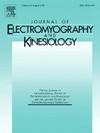估算开销工作的最大可接受占空比(MADC)
IF 2.3
4区 医学
Q3 NEUROSCIENCES
引用次数: 0
摘要
由于抬高的手臂姿势和持续的负荷,头顶工作对肩部肌肉骨骼疾病有很大的风险,但目前的人体工程学工具对此类任务可接受的时间百分比提供了有限的指导。这个概念被称为最大可接受占空比(MADC),它代表了在一个工作周期内,一种努力可以维持在心理上可接受的水平上的时间比例。本研究通过重新配置现有的用于架空作业的人体工程学评估工具来估计MADC,而不是最大可接受力,从而解决了这一差距。在三种优越定向负载条件下(5、10和20 N),通过计算建模绘制了整个架空工作区的MADC值。MADC随手的位置和力的需求变化很大:在5 N时,数值范围为0 - 40%,而在20 N时,MADC从未超过14%。一个符合人体工程学的“最佳点”被确定在肩膀的上方和前方,MADC最大化,为允许的任务工作周期提供最大的设计空间。重新配置的工具通过告知工业环境中的占空比限制,为开销任务设计提供了可操作的、基于证据的指导,而目前的一刀切阈值缺乏经验证明。本文章由计算机程序翻译,如有差异,请以英文原文为准。
Estimating maximum acceptable duty cycles (MADC) for overhead exertions
Overhead work poses a significant risk for shoulder musculoskeletal disorders due to elevated arm postures and sustained loading, yet current ergonomics tools provide limited guidance on the acceptable percentage of time such tasks can be performed. This concept, referred to as the Maximum Acceptable Duty Cycle (MADC), represents the proportion of time within a work cycle that an exertion can be sustained at a psychophysically acceptable level. This study addresses that gap by reconfiguring an existing ergonomics assessment tool for overhead work to estimate MADC, rather than maximum acceptable forces. MADC values across the overhead workspace were mapped using computational modeling of over 800,000 overhead hand positions under three superior-directed load conditions (5, 10, and 20 N). MADC varied substantially with hand position and force demand: at 5 N, values ranged from 0–40 %, while at 20 N, MADC never exceeded 14 %. A consistent ergonomic ‘sweet spot’ was identified slightly above and forward of the shoulder, where MADC is maximized, providing the largest design space for allowable task duty cycles. The reconfigured tool offers actionable, evidence-based guidance for overhead task design by informing duty cycle limits in industrial settings, where current one-size-fits-all thresholds lack empirical justification.
求助全文
通过发布文献求助,成功后即可免费获取论文全文。
去求助
来源期刊
CiteScore
4.70
自引率
8.00%
发文量
70
审稿时长
74 days
期刊介绍:
Journal of Electromyography & Kinesiology is the primary source for outstanding original articles on the study of human movement from muscle contraction via its motor units and sensory system to integrated motion through mechanical and electrical detection techniques.
As the official publication of the International Society of Electrophysiology and Kinesiology, the journal is dedicated to publishing the best work in all areas of electromyography and kinesiology, including: control of movement, muscle fatigue, muscle and nerve properties, joint biomechanics and electrical stimulation. Applications in rehabilitation, sports & exercise, motion analysis, ergonomics, alternative & complimentary medicine, measures of human performance and technical articles on electromyographic signal processing are welcome.

 求助内容:
求助内容: 应助结果提醒方式:
应助结果提醒方式:


